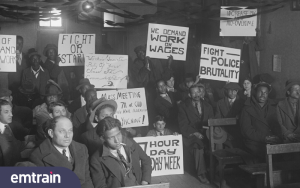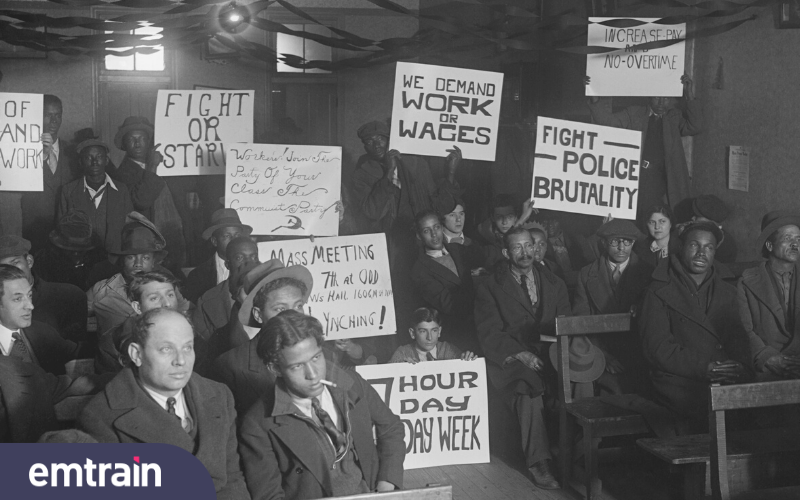Rapid social and economic changes. Sizeable population increase of non-white, non-western European people. Women fighting for more power and opportunity. Technological advances that eliminate jobs and trigger a big focus on growth, but little focus on social impact.
Sound familiar? These dynamics describe today’s environment, but they also describe the dynamics in the early 1920s. As outlined below, an examination of the 1920s workforce trends provides insight on the likely labor trends we’ll see this year and moving forward.
Changing Demographics

By 1920, the United States had experienced an influx of immigrants, visibly changing its social demographics. Thirteen percent (13%) of the U.S. were immigrants and many of those immigrants came from countries other than Western Europe – Southern & Eastern Europe and Asia. The white anglo Saxon protestant majority felt uncomfortable with the demographic changes and the social friction led to the National Origin Act of 1924, which put strict quotas on immigration from non-Nordic countries. Sound familiar? Generational tension also existed between the older generation, accustomed to strict Victorian-era social norms and the younger, flapper generation who had more relaxed social norms relating to class and race.
Prediction
Gen Z is now entering the workforce, the most diverse demographics in our history, with very fluid social norms on race, sex, and gender. Our social norms are changing and we’ll continue to experience social friction in the workforce as the majority of society adjusts to new norms.
Diversity leaders will need to have a dual-track strategy. On one track, you’ll need to keep pushing for diversity and inclusion throughout the organization to remain competitive. On the other track, you’ll need to be supportive and connect with people who may not feel comfortable with the rapid social changes. Start a dialogue, acknowledge their fears, and gently coax them to a more modern view. If you castigate or alienate them, it’ll trigger workforce friction and conflict.
Push for Gender Parity
Women fought to get the right to vote in 1920. The late teens and early twenties saw the first women’s movement to gain economic and social autonomy as women entered the workforce in significant numbers. The women in the 1920s fought for economic and social freedom and we’re experiencing similar dynamics right now.
Prediction
We’re in another wave of women fighting for social and economic parity and until we’ve achieved that at the source of power, we’ll continue to experience a lot of friction downstream in the workforce – in harassment, bias, and compensation claims. Only when women get an equal amount of capital to start unicorn businesses and participate at the Board or C-Suite level, will we see a reduction in workforce friction.
It’s also important to point out that the new mandates in unconscious bias training for specific jobs, which will expand in 2020, and there’s a growing mobilization to lower the legal standard for harassment. Harassment can only occur when there’s an unequal power dynamic so it’s fair to say that more women at the top, influencing workplace culture, would reduce the amount of sexual harassment experienced by women each year. So, until we reach gender parity at the top, we’ll continue to see increased claims and regulations to advance women in the workforce.
Changing Employer/Employee Relationship
As the U.S. continued to experience industrialization in the 1920s, many agrarian workers were displaced and automation changed the nature and type of jobs available. There was also a focus on technological progress, without a comparable focus on employee conditions, wages and social impact. It’s not surprising that the rapidly changing economy triggered great wealth and great poverty at the same time. The great wealth/great poverty tension eventually led to the rise of socialism and communism in the 1920s as well as workers mobilizing and unionizing to fight for better treatment.
Prediction 1
We now live in a digital, gig economy that is changing the nature of work, automating and eliminating jobs, displacing employees and converting other employees into independent contractors so that a portion of our society is working 2 or 3 jobs to make ends meet. The net/net is that employees have less trust in business and less faith that employer agents will protect their interests.
Given the ease to informally organize and collaborate on the web, employees will increasingly mobilize to push for needed changes that represent their interests. When employees don’t agree with management policies and/or feel the need to push back on management power, expect more change.org petitions, organized walkouts and demonstrations, and more.
Prediction 2
As employees have less trust and faith in their employer to represent their interests, they have higher near term expectations for their employee experience. Employees increasingly expect non-monetary rewards from work, such as an inspiring company mission, a healthy workplace culture, professional development, skilled managers, transparency and candor, positive social impact, and other workplace culture characteristics.
Talent leaders need to continue thinking about what they’re offering people aside from a paycheck. Is it professional development? An inspiring social mission? A unique workplace culture? As the nature of the employer/employee relationship keeps evolving, employees will continue to expect an optimal employee experience in addition to a paycheck. So, a focus on the employee experience is critical in 2020 to recruit top talent and be competitive.
Conclusion
Given the significant social and economic changes impacting today’s workforce, HR, Talent, and Diversity leaders will be increasingly strategic and valuable to the business and will likely have more influence on the organization. My prediction is that 2020 will likely be the year of the #culturekeeper.
To learn more about the latest workplace trends, follow Emtrain on LinkedIn and stay tuned for our next episode of #AlwaysLearning on LinkedIn Live.








